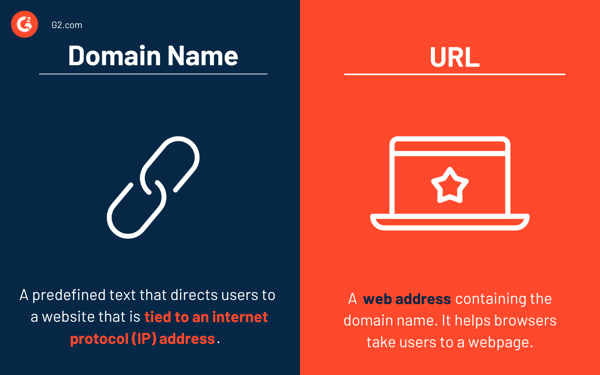
In today's digital age, having a strong online presence for your business is essential.
But before you can build a website or launch your dream blog, you need a foundation: a memorable domain name.
A domain name is the unique address of a website on the internet. It is used in a Uniform Resource Locator (URL) to identify particular web pages.
For example, in the URL https://www.g2.com/categories/crm, the domain name is g2.com. The domain name consists of two parts, one being the name (g2) and the other being the extension (.com).
But how do you get the right domain? That's where domain registration services come in. Choosing the right domain registrar can make all the difference – it can be a smooth and secure process or a frustrating hurdle.
This article will guide you through the key factors to consider when selecting a domain name, helping you secure the perfect online address for your business.
Lots of folks mix up the URL and the domain name, but they're not exactly the same. The domain name is part of the URL, sort of like a nickname for a website. It's what you type into your browser to get to a specific site, made up of letters, numbers, and sometimes hyphens.

Now, the URL is the whole web address. It includes the domain name, sure, but it's more than that. It also has stuff like "http://" or "https://" at the beginning, showing how your browser should connect to the site. Plus, it might have extra info pointing to a specific page or file within the site.
So, while the domain name is like the name of the place, the URL gives you directions to exactly where you want to go inside that place.
Behind the scenes, domains play a crucial role in translating website names into something computers can grasp: IP addresses. So, when you type a domain name like "google.com" into your web browser, your computer doesn't automatically know where to go. Instead, it sends a request to a domain name system (DNS) server.
This DNS server gets your request and reviews its records to find the matching IP address for "google.com". Sometimes, there's a whole chain of DNS servers involved, especially for complex domain name setups.

After the DNS server tracks the right IP address, it returns that to your computer, which has the IP address, which is the actual location of the website's files on the internet.
Using this IP address, your computer connects to the web server that hosts the website's files. The web server retrieves the requested files (HTML code, images, etc.) and sends them back to your computer.
Your computer interprets the received files and displays the website on your web browser.
There are three main elements of domain names: top-level domains, second-level domains, and third-level domains. Let's explore them in depth
When you look at a website address, the part after the last dot is called the top-level domain (TLD). It's like a digital flag that tells you what the website is about or where it's from.
These are like digital flags that show which country a website is associated with. Examples include ".us" for the United States, ".uk" for the United Kingdom, ".ca" for Canada, etc.
These are common types like .com, .org, and .net, but there are also newer ones like .blog or .shop that can give you a more specific hint about what the website is for.
The part of the website address just before the TLD is called the second-level domain. It's basically the unique name chosen by the website owner. For example, in "google.com," "google" is the SLD.
These are additional hierarchy levels that can exist before the SLD and TLD in a website address. They help organize content within a website.
For instance, in "mail.google.com," "mail" is the third-level domain or subdomain. So, it clearly tells you it's a specific section within the larger Google website.
When you choose a domain name for your website, think of it as your home address. Just as your home address helps people find your physical location, your domain name helps users find your website online.
Because a website domain has to be registered, no two website domain names are the same. It's a unique identifier. A memorable name with relevant keywords will impact your website’s search engine optimization (SEO) positively and improve it's rankings on the search engine results page (SERP).
Perform a domain name search first. If your desired domain name is already taken, use WHOIS to uncover the owner's contact information. There are plenty of WHOIS lookup or search tools that can help you do this easily. Then, craft a professional email inquiring whether the domain owner is open to selling.
Following these tips, you can select a perfect domain name that effectively represents your brand and helps you stand out online. Remember that your domain is what customers and viewers of your website will associate with your brand, so it’s not something to be rushed and taken lightly.
There are domain registration service providers that help businesses search for domains and check for their availability. Domain name registrars are used by businesses that wish to create and maintain a website, or to reserve a domain name for future business opportunities.
To find the right fit, look at what each tool offers.
Choosing a domain registrar depends on your needs, priorities, and budget. Here are some of the top service providers in 2024:
* These are the five leading domain registration providers from G2's Spring 2024 Grid® Report.
Some website builder platforms offer a package that includes domain registration if you don’t want to register your name separately as you build your website.
It’s important to remember that web hosting is separate from registering your domain name. After registering your domain, choose a web hosting service provider that covers all your needs, like online store features, web hosting, SSL certificates, and more.
If you’re considering getting a domain name, it’s best to act fast. Thousands of new domains are registered daily, so the catchy and clickbaity domain name you thought of yesterday could be gone today if you wait too long.
The cost of a domain name, which is your website's address online, can vary depending on the chosen domain registrar and a few other factors.
The biggest cost influencers are the domain extension (like .com or .org) and whether it's a premium domain name (an already registered, desirable name).
Generally, new domains with popular extensions like .com range from $10 to $15 per year, but some registrars might offer introductory discounts or higher renewal fees.
Selling a domain name involves finding a buyer willing to pay your asking price, which requires research on similar domain sales to set a fair price. Factors like memorability, brand-ability, and relevance to a niche affect a domain's value.
To sell, utilize platforms for auctions, escrow services, and broad buyer reach, or employ a domain broker for specialized assistance. Create a detailed listing highlighting your domain's strengths and set a realistic price based on research and desired profit margins, offering fixed pricing or negotiation options.
As you can see, a lot goes into choosing a domain name. There are many factors to consider, as it’ll represent your website brand for (hopefully) years. Deciding upon and registering your domain name are must-do steps for website building, so brainstorm potential ideas and get ready to fully commit to whatever domain name you choose.
Curious about crafting your own website? Explore our top website builders to kickstart your online journey.
This article was originally published in 2019. It has been updated with new information.
Mara Calvello is a Content and Communications Manager at G2. She received her Bachelor of Arts degree from Elmhurst College (now Elmhurst University). Mara writes content highlighting G2 newsroom events and customer marketing case studies, while also focusing on social media and communications for G2. She previously wrote content to support our G2 Tea newsletter, as well as categories on artificial intelligence, natural language understanding (NLU), AI code generation, synthetic data, and more. In her spare time, she's out exploring with her rescue dog Zeke or enjoying a good book.
If your business sends more than 5000 emails daily, DMARC is no longer optional.
 by Soundarya Jayaraman
by Soundarya Jayaraman
Your email reputation can make or break a campaign. But what happens when your carefully...
.png) by Tanuja Bahirat
by Tanuja Bahirat
Given the rapid pace of technological development, attackers are constantly finding new ways...
 by Samudyata Bhat
by Samudyata Bhat
If your business sends more than 5000 emails daily, DMARC is no longer optional.
 by Soundarya Jayaraman
by Soundarya Jayaraman
Your email reputation can make or break a campaign. But what happens when your carefully...
.png) by Tanuja Bahirat
by Tanuja Bahirat


